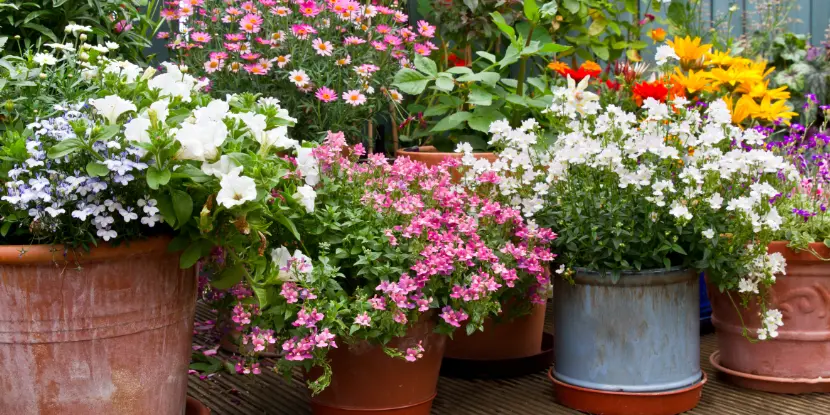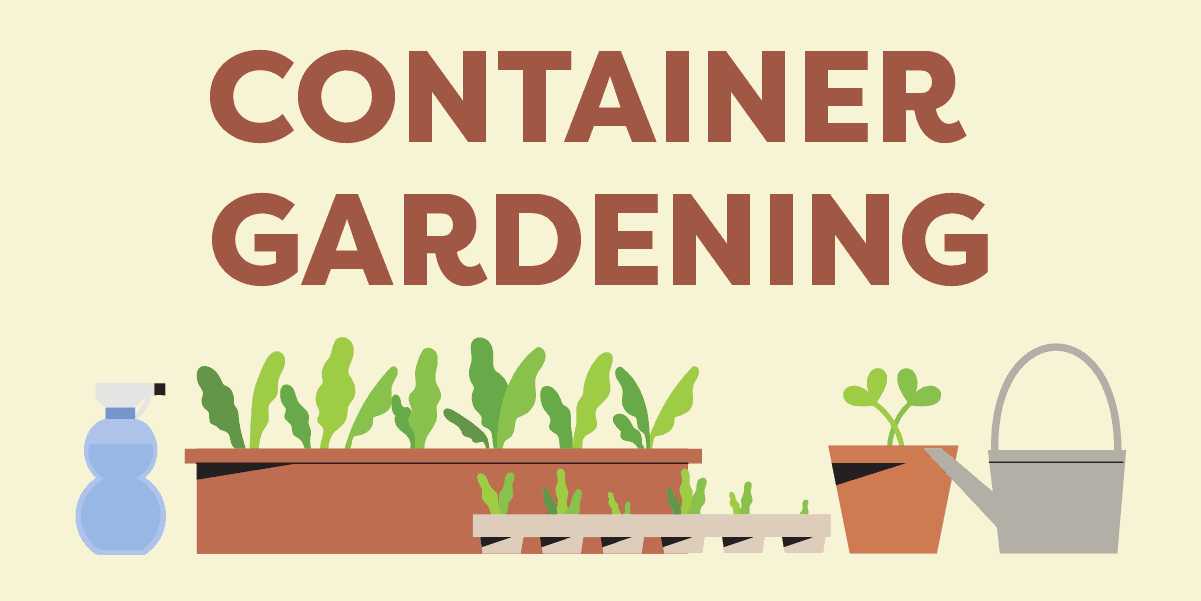Perfect for people with limited gardening space, container gardening is a wonderful way to beautify your surroundings and improve an urban, porch, or patio environment.
Since most containers are portable, you’ll be able to move your plants around and give your living area an instant color accent. For instance, a container filled with flowering annuals or perennials and a clump of tall ornamental grass makes an elegant statement by your doorstop or near your patio.
Containers come in all styles and sizes. Even old buckets, milk cans, and wheelbarrows can be recycled into planters. Just be sure these containers have holes for adequate water drainage.

A gorgeous flower container garden.
When choosing a container:
- Ensure the container is big enough to support the plants you’re putting in it.
- Ensure there’s adequate drainage.
- Never use a container that has held products harmful to plants or people.
Clay containers are long-time favorites of gardeners. But remember that clay is porous, and moisture evaporates faster. Also, clay containers are more fragile and heavier than plastic.
Wood is another popular material. Redwood and cedar containers are rot-resistant but not immune.
Potting Soil
Regular garden soil may not drain well. Poor drainage can make it difficult for air to reach the roots of your plants.
On the positive side, garden soils contain more microorganisms and micronutrients that benefit plant growth. With the help of an Anawalt nursery professional, you can create the best planting media for your needs.

Container-grown herbs and leafy greens.
Anawalt offers several choices of soil for your container planting:
- Premium Soil – Made with indoor plants in mind. The soil has a rich organic base of peat moss, composted bark, and a small nutrient charge with some perlite added for texture and appearance.
- Organic Humus – This soil mix contains minerals, peat moss, and composted bark mulch.
- Top Soil Mix – An ideal “fill in” soil mix for all purposes. It mix works well for filling in low areas in your yard, blending with potting soil to add weight, or as a standalone planting mix. Topsoil mix is excellent for containers because it has added sand, which will increase your container weight, making it less likely to blow over on a windy day.
- Rose Planting Mix – This carries a virtually neutral pH and has no added nutrient package. It’s formulated for hibiscus, Mandevilla, plumeria, and all patio container plants.
What to Grow
Take a walk through our garden center for ideas. All annuals, especially heat-tolerant ones, do well in containers.
Here are some general tips to consider.
- Think logically when planting in containers. Plant shade-loving plants together and sun-loving plants together. Also, remember that both groups of plants have different watering needs.
- Consider layers, textures, and colors when making your selection. Masses of color work best in smaller areas. Whiskey barrels containing a tall accent perennial with a low border of annuals and cascading or trailing ivy along the barrel’s rim lend a tidy look to your outside area.
- Watch how you water. Allow enough water to saturate the pot until you see water coming out from the drain holes. Avoid using a direct stream from a hose. Some containers drain more rapidly than others. Small containers usually retain less moisture. When you water should depend on the type of plant, potting mix, and weather conditions. In the hot summer, you may need to water once or twice every day.
- Regularly feed your plants. The addition of a slow fertilizer at planting time will help, but regular feeding during the growing season will give you optimum performance.
- Consider adding mulch. An organic layer of mulch will reduce water evaporation and keep the soil cool, but it also makes your containers more attractive.
- Don’t forget to “deadhead.” This term refers to the removal of dead blossoms to encourage more blooming. Unless you have planted vegetables, berries, or fruits, you shouldn’t promote your annuals to produce fruit of seed if you want to have color all season long. On the other hand, systematically collecting seeds for replanting keeps many old gardens going strong. This will not preserve hybrid varieties, but you’ll have robust plants returning year after year.

An abundant container tomato garden.
Water Conservation
Containers allow you to control the amount and distribution of water to specific plants. Check your containers at least once a day, twice on hot, dry, or windy days. Feel the soil to determine whether it’s damp.
If you’re away from home often, consider an automatic drip irrigation system, available with timers that can be set to water on a schedule and operate for weeks on batteries. Of course, you can also use more elaborate electronic watering systems available at Anawalt Lumber.
How to Plant
- Place a piece or two of broken pottery over the bottom hole of your container. This will help prevent soil from washing out of the pot. Gravel in the bottom of the hole will add weight but will not increase the drainage.
- Lay out what is going into each container. Remember the sizes of plants full-grown.
- Plant one plant at a time, beginning in the center and working out to the edges.
- Scoop out a hole to start with, place a bit of slow-release fertilizer in the hole, put a plant in the hole, fill in around the roots, and take care not to break or damage tender branches of nearby plants. Proceed to the next plant.
- When all the plants are in the container, add a little more soil to make sure it’s filled to about 1 inch from the top of the container. Then gently “water in” the new plants.
- Mulch was mentioned earlier as an attractive top layer, but small gravel or stones also work nicely to keep the soil in place, especially during heavy rains.
Container gardening is not just a trend. Potted bonsai trees have been around for hundreds of years. Oranges were planted in containers at the Palace of Versailles. Learn to enjoy the beauty of gardening in containers and live like the Queen of France (pre-revolution, of course).
Below: How to plant tomatoes in pots.
FAQs: More about Container Gardening
Q: What type of soil should I use for my container plants?
Use a high-quality potting mix that provides good plant drainage and aeration. Avoid garden soil, which can be too dense, potentially causing waterlogging and root diseases.
Q: How often should I water my container plants?
The watering frequency depends on the type of plants, the size of the container, and the ambient temperature. A general rule is to water when the top inch of soil feels dry to the touch.
Q: Do container plants need fertilizer?
Container plants benefit from regular fertilizing since potting mix has limited nutrients. Use a balanced, water-soluble fertilizer every 4-6 weeks during the growing season.
Q: How much sunlight do my container plants need?
This varies by plant species. Most edible plants need at least 6-8 hours of direct sunlight daily, while some ornamental plants may thrive in partial shade.
Q: Can I grow perennials in containers?
Many perennials can live in containers for several years. Choose a container that can accommodate the plant’s growth and offers adequate drainage.
Q: What’s the best way to prevent pests in my container garden?
Regularly inspect your plants for signs of pests, and intervene early with organic pest control methods, such as neem oil or insecticidal soap.
Q: How do I choose a suitable container for my plants?
Select containers with enough space for your plant’s root system. They should have drainage holes. Consider the material; for example, terracotta pots are porous and allow soil to dry quicker than plastic or ceramic containers.
Q: What should I do if my container plant’s leaves turn yellow?
Yellowing leaves can indicate overwatering, under-watering, or nutrient deficiency. Adjust your watering schedule and consider applying a balanced fertilizer.
Q: Can I reuse potting mix for new plants?
Yes, but you should rejuvenate the mix by adding fresh potting mix and slow-release fertilizer to ensure it has enough nutrients for the new plants.
Q: How can I protect my container plants from cold weather?
Move containers to a sheltered location, use pot insulators, or wrap the container with burlap or bubble wrap. For sensitive plants, consider bringing them indoors during extreme cold.

